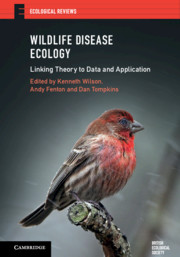Book contents
- Wildlife Disease Ecology
- Ecological Reviews
- Wildlife Disease Ecology
- Copyright page
- Contents
- Contributors
- Preface: Wildlife Disease Ecology
- Glossary of Terms
- Part I Understanding within-host processes
- Part II Understanding between-host processes
- Chapter Eight Using insect baculoviruses to understand how population structure affects disease spread
- Chapter Nine Infection and invasion: study cases from aquatic communities
- Chapter Ten Parasite-mediated selection in red grouse – consequences for population dynamics and mate choice
- Chapter Eleven Emergence, transmission and evolution of an uncommon enemy: Tasmanian devil facial tumour disease
- Chapter Twelve Bovine tuberculosis in badgers: sociality, infection and demography in a social mammal
- Chapter Thirteen Mycoplasma ovipneumoniae in bighorn sheep: from exploration to action
- Chapter Fourteen Manipulating parasites in an Arctic herbivore: gastrointestinal nematodes and the population regulation of Svalbard reindeer
- Part III Understanding wildlife disease ecology at the community and landscape level
- Index
- Plate Section (PDF Only)
- References
Chapter Ten - Parasite-mediated selection in red grouse – consequences for population dynamics and mate choice
from Part II - Understanding between-host processes
Published online by Cambridge University Press: 28 October 2019
- Wildlife Disease Ecology
- Ecological Reviews
- Wildlife Disease Ecology
- Copyright page
- Contents
- Contributors
- Preface: Wildlife Disease Ecology
- Glossary of Terms
- Part I Understanding within-host processes
- Part II Understanding between-host processes
- Chapter Eight Using insect baculoviruses to understand how population structure affects disease spread
- Chapter Nine Infection and invasion: study cases from aquatic communities
- Chapter Ten Parasite-mediated selection in red grouse – consequences for population dynamics and mate choice
- Chapter Eleven Emergence, transmission and evolution of an uncommon enemy: Tasmanian devil facial tumour disease
- Chapter Twelve Bovine tuberculosis in badgers: sociality, infection and demography in a social mammal
- Chapter Thirteen Mycoplasma ovipneumoniae in bighorn sheep: from exploration to action
- Chapter Fourteen Manipulating parasites in an Arctic herbivore: gastrointestinal nematodes and the population regulation of Svalbard reindeer
- Part III Understanding wildlife disease ecology at the community and landscape level
- Index
- Plate Section (PDF Only)
- References
Summary
Parasites inflict many costs on their hosts. Understanding host–parasite relationship eco-evolutionary dynamics needs appreciation of how parasites affect individual fitness, survival and reproductive potential, and how they combine to influence population demography, dynamics and viability; also, how these processes drive microevolutionary processes that define natural and sexual selection. We synthesise work on the relationship between the red grouse and its main parasite, a gastrointestinal nematode. At individual level, we show how parasites impose a physiological cost, measured by immunosuppression and increased oxidative stress, and how their impact varies depending on contexts. We describe how parasite infection constrains expression of sexually selected traits and summarise how relationships between parasite, host and environment shape host population demography and dynamics. Genetic analyses in red grouse suggest nematode burden is moderately heritable, underpinned by a potentially large array of genes involved in the immune system, energy balance and broader homeostatic processes. There is no clear association between allele frequencies among populations and differences in nematode burdens. Possibly, beneficial alleles for parasite resistance cannot spread through the population due to the strong diversifying e?ects of gene ?ow and genetic drift.
Keywords
- Type
- Chapter
- Information
- Wildlife Disease EcologyLinking Theory to Data and Application, pp. 296 - 320Publisher: Cambridge University PressPrint publication year: 2019
References
- 2
- Cited by



